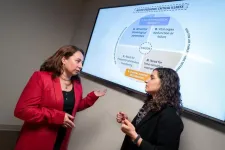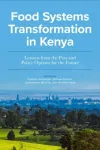(MEMPHIS, Tenn. – January 05, 2023) St. Jude Children’s Research Hospital investigators collaborated with a global group of acute pediatric critical illness experts to reach a consensus definition of the condition. Research on how to improve care in low- and middle-income countries has been stymied because conventional pediatric critical illness definitions are not applicable in these settings. The new, more universal definition, reached by consensus among researchers and clinicians from 40 countries, will enable scientists to study pediatric critical illness more universally, which should lead to improvements in patient outcomes globally. The full definition was published today in The Lancet Global Health.
“We now have a common language for acute pediatric critical illness,” said first and corresponding author Anita Arias, M.D., St. Jude Department of Pediatric Medicine. “That shared understanding will improve data collection globally and increase patient sample size, which will lead to more and better clinical studies of evidence-based interventions.”
The new full definition is: “An infant, child or adolescent with an illness, injury or post-operative state that increases the risk for or results in acute physiological instability (abnormal physiological parameters or vital organ dysfunction or failure) or a clinical support requirement (such as frequent or continuous monitoring, or time-sensitive intervention) to prevent further deterioration or death. The patient can meet this definition by having physiological instability, support requirements or both.”
St. Jude researchers, led by Arias and senior author Asya Agulnik, M.D., MPH, St. Jude Global Critical Care director, coordinated an international group of acute pediatric critical illness researchers and clinicians to assemble the definition. In total, 109 experts from 40 countries contributed. The participants used a method called modified Delphi, which anonymized those involved so they could freely vote and express their opinions on draft statements. The final definition was a consensus among these experts, with particular attention to being more inclusive of hospitals of differing resource levels.
A more inclusive patient-centered definition
Historically, acute pediatric critical illness has had many definitions. Studies from higher-income countries tend to use definitions that include technical or resource-based terminology, such as admission to an Intensive Care Unit (ICU). While that criterion has proven clinically useful, it does not translate to resource-limited health care settings in other countries, which may not have an ICU in their hospitals.
“With our new framework, we’re trying to be more inclusive,” Arias said. “As many hospitals around the world don’t even have an ICU, older definitions were excluding a huge population of patients from research.”
“While the global burden of childhood mortality is mostly in low-and middle-income countries, to date, the study of acute pediatric critical illness has largely been centered on hospitals in high-resource settings,” Agulnik said. “This definition, which allows for classification of patients as critically ill regardless of critical care resources, would address this research disparity by facilitating research in hospitals of all resource settings.”
The focus on ICUs reveals a larger problem: previous definitions excluded patients experiencing acute critical illness but lacking access to critical care resources. To increase inclusivity, the international group recognized the need to define the condition based on the patient’s status rather than on resources, such as specific department admission or intervention use.
“One example of why we needed a new definition is the studies of respiratory failure,” Arias explained. “Traditionally, these studies include patients who are on mechanical ventilation, but the fact that a hospital might not have mechanical ventilation doesn’t mean that the patient doesn't have acute respiratory illness or failure.”
The new definition focuses on the patient to address that need without regard to local resources. It looks at two different states — what is happening with the patient’s bodily systems, and the need for clinical support, such as needing a ventilator, but not the actual materials used to address the patient’s needs.
The framework also provides eight attributes and 28 statements to clarify and explain its application. The entirety of that framework is termed the DEFinition for acute pediatric CRITical illness (DEFCRIT).
Improving care globally
Slow improvement in critical care can be attributed to the historical lack of a standardized and inclusive definition of acute pediatric critical illness, particularly in low- and middle-income countries. Given the difficulty in adapting methods to these settings, even measuring the total burden of critical illness has evaded researchers. DEFCRIT will help lead to a better understanding of the burden of disease and begin to compare populations and interventions in a more standardized and inclusive way.
“We have started bridging a gap for researchers and clinicians to understand the global burden of critical illness,” Arias said. “This could eventually lead to better care delivery by gaining the ability to determine how effective intervention can be in different populations, environments and stages of illness.”
Multiple global groups of pediatric disease researchers have already accepted DEFCRIT. The Pediatric Acute Lung Injury and Sepsis Investigators (PALISI) Network on Behalf of the PALISI Global Health Subgroup is a co-author of the paper. In addition, the World Federation of Pediatric Intensive and Critical Care Societies (WFPICCS) and the Society of Critical Care Medicine (SCCM) both endorsed the framework.
“There was an iniquity in research that we, as a global group, wanted to address,” Arias said. “With a universal DEFCRIT, we’ve stopped impeding research progress. We’re now going to be able to start pushing the field toward improving the care for patients globally through better research.”
Authors and funding
The study’s other authors are Abdelhafeez Abdelhafeez, of St. Jude; Teresa Kortz, University of California, San Francisco; Michael Lintner-Rivera, Adnan Bhutta, Indiana University School of Medicine; Nadeem Shafi, University of Tennessee Health Science Center and Le Bonheur Children’s Hospital; Qalab Abbas, Aga Khan University Hospital; Muhammad Ali, Pakistan Institute of Medical Sciences; Hala Ammar, Children’s Hospital of Benghazi; Ali Anwar, Lincoln Memorial University-DeBusk College of Osteopathic Medicine; John Adabie Appiah, Komfo Anokye Teaching Hospital; Jonah Attebery, University of Colorado; Willmer Diaz Villalobos, Unidad de Terapia Intensiva Pediátrica del Hospital Materno Infantil; Daiane Ferreira, Barretos Children’s Hospital; Sebastián González-Dambrauskas, LARed Network, Centro Hospitalario Pereira Rossell and Universidad de la República; Muhammad Irfan Habib, ChildLife Foundation; Jan Hau Lee, KK Women's and Children's Hospital and Duke-NUS Medical School; Niranjan Kissoon, BC Children's Hospital; Atnafu Mekonnen Tekleab, Saint Paul's Hospital Millennium Medical College; Elizabeth Molyneux, Kamuzu University of Health Sciences; Brenda Morrow, University of Cape Town; Vinay Nadkarni, Children's Hospital of Philadelphia; Jocelyn Rivera, Hospital Infantil Teletón de Oncología; Rebecca Silvers, University of California, San Francisco; Mardi Steere, Women’s and Children’s Hospital and Royal Flying Doctor Service; and Daniel Tatay, Hospital de Niños de la Santísima Trinidad.
The study was supported by ALSAC, the fundraising and awareness organization of St. Jude.
St. Jude Media Relations Contacts
Chelsea Bryant
Cell: (256) 244-2048
Desk: (901) 595-0564
chelsea.bryant@stjude.org
media@stjude.org
Rae Lyn Hartley
Cell: (901) 686-2597
raelyn.hartley@stjude.org
media@stjude.org
St. Jude Children’s Research Hospital
St. Jude Children’s Research Hospital is leading the way the world understands, treats and cures childhood cancer, sickle cell disease and other life-threatening disorders. It is the only National Cancer Institute-designated Comprehensive Cancer Center devoted solely to children. Treatments developed at St. Jude have helped push the overall childhood cancer survival rate from 20% to 80% since the hospital opened more than 60 years ago. St. Jude shares the breakthroughs it makes to help doctors and researchers at local hospitals and cancer centers around the world improve the quality of treatment and care for even more children. To learn more, visit stjude.org, read St. Jude Progress blog, and follow St. Jude on social media at @stjuderesearch.
END




